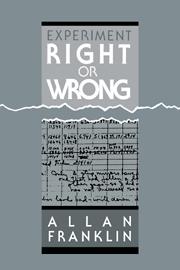Experiment Right or Wrong

In Experiment, Right or Wrong, Allan Franklin continues his investigation of the history and philosophy of experiment presented in his previous book, The Neglect of Experiment. In this new study, Franklin considers the fallibility and corrigibility of experimental results and presents detailed histories of two such episodes: 1) the experiment and the development of the theory of weak interactions from Fermi's theory in 1934 to the V-A theory of 1957 and 2) atomic parity violation experiments and the Weinberg-Salam unified theory of electroweak interactions of the 1970s and 1980s. In these episodes Franklin demonstrates not only that experimental results can be wrong, but also that theoretical calculations and the comparison between experiment and theory can also be incorrect. In the second episode, Franklin contrasts his view of an "evidence model" of science in which questions of theory choice, confirmation, and refutation are decided on the basis of reliable experimental evidence, with that proposed by the social constructivists.
That work [Wu-Schwarzchild] was completed in November 1957,6 and was known to Rustad and Ruby, who were doing their own reexamination. No record of this reexamination seems to be available7 but in a post-deadline paper given at the January 1958 meeting of the American Physical Society, Rustad and Ruby suggested that their earlier result might be wrong.8
6 Letter from C. S. Wu to P. Cavanagh, May 19, 1958. I am grateful to Brian Ridley for providing me with this letter.
7 Dr. S. Ruby, private communication.
8 There are no abstracts of postdeadline papers, but the talk is cited in Burgy et al. (1958( and Commins and Kusch (1958). Dr. Ruby (private communication) remembers the tone of the paper as mea culpa.